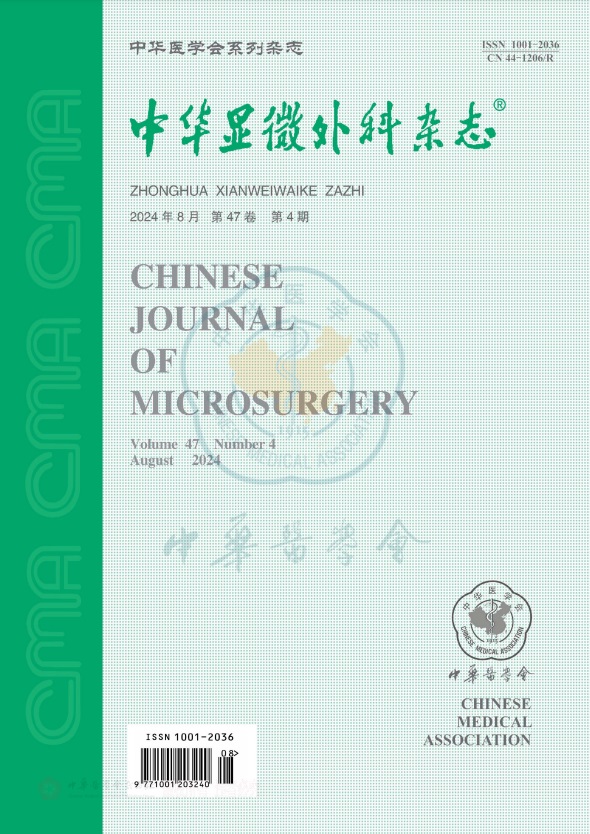改良大腿前外侧薄皮瓣重建手足缺损
引用次数: 0
摘要
目的评价改良股前外侧薄皮瓣修复手足缺损的临床效果。方法2016年3月~ 2017年9月,对17例患者行改良股前外侧薄皮瓣重建。手部重建6例,其中3例位于手部背侧缺损。踝关节足部再造术11例,其中足背部再造术5例。皮瓣大小为5 cm×3 cm-33 cm×10 cm。传统的穿支皮瓣被提升到深筋膜平面上方。在切除椎弓根之前,可以进行减体积手术。改进的方法是将皮瓣从浅筋膜和深浅脂肪之间的平面提升,而不需要术中减压。结果3个皮瓣在血肿引起的二次探查手术后最终成活。2个皮瓣部分丢失,其中1个需要二次植皮,另一个皮瓣愈合。随访3 ~ 18个月,平均7个月。所有皮瓣外形均较好,患者临床效果满意。结论穿支皮瓣从浅筋膜及深浅脂肪间平面上提起是一种安全可靠的方法。它可以立即获得薄皮瓣,减少供区发病率,而无需额外脱脂和耗时。皮瓣柔软,轮廓好。这项技术是一个理想的选择,覆盖缺陷组成的手背或足和头颈部区域。关键词:股前外侧皮瓣;穿支皮瓣;薄型皮瓣的改进方法;显微外科手术本文章由计算机程序翻译,如有差异,请以英文原文为准。
Modified thin anterolateral thigh flaps for reconstruction of hand and foot defects
Objective
To evaluate the clinical efficacy of modified thin anterolateral thigh flaps for reconstruction of hand and foot defects.
Methods
Between March, 2016 and September, 2017, 17 patients were reconstructed with modified thin anterolateral thigh flap. There were 6 cases for reconstruction of hand, and 3 of them were located in the back dorsal of hand defects. There were 11 cases for reconstruction of ankle and foot, and 5 of them were located in the dorsal of foot. The size of the flap was 5 cm×3 cm-33 cm×10 cm. The traditional perforator flap was elevated just above the deep fascial plane. The debulking procedures could follow before the pedicle was cut off. The modified method was that the flap was elevated from the superficial fascia and the plane between deep and superficial fat without intraoperative debulking procedures.
Results
Three flaps were eventually survived after secondary exploratory operation caused by the hematoma. Two flaps had partial loss, 1 of which needed secondary skin grafting, and the other flap healed with additional intention. Followed-up period was 3-18(average, 7) months . All flaps showed relatively good contour and the patients were satisfied with clinical outcomes.
Conclusion
It is a safe and reliable way that perforator flap can be elevated from the superficial fascia and the plane between deep and superficial fat. It can obtain a thin flap immediately and reduce donor-site morbidity without additional defatting and time-consuming. The flap is soft with good contour. This technique is an ideal option for covering defects composed of dorsal of the hand or foot and the head and neck regions.
Key words:
Anterolateral thigh flap; Perforator flap; Modified method of thin type flap; Microsurgical operation
求助全文
通过发布文献求助,成功后即可免费获取论文全文。
去求助
来源期刊
CiteScore
0.50
自引率
0.00%
发文量
6448
期刊介绍:
Chinese Journal of Microsurgery was established in 1978, the predecessor of which is Microsurgery. Chinese Journal of Microsurgery is now indexed by WPRIM, CNKI, Wanfang Data, CSCD, etc. The impact factor of the journal is 1.731 in 2017, ranking the third among all journal of comprehensive surgery.
The journal covers clinical and basic studies in field of microsurgery. Articles with clinical interest and implications will be given preference.

 求助内容:
求助内容: 应助结果提醒方式:
应助结果提醒方式:


